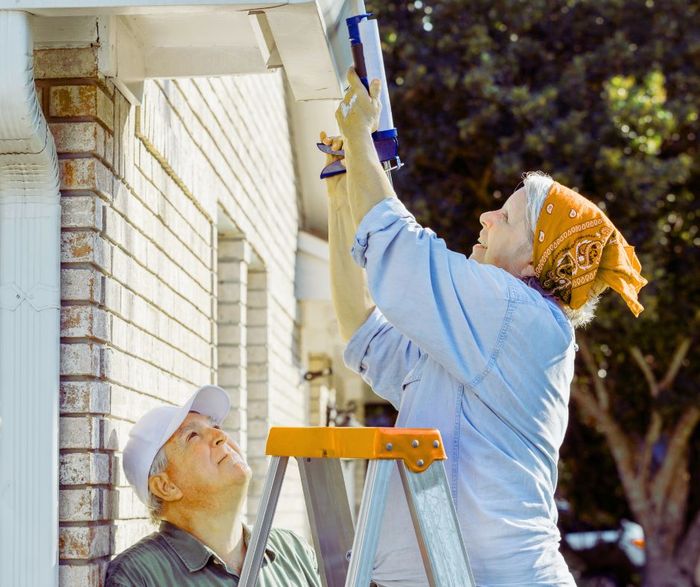Overwhelmed by Home Maintenance? Suggestions to Help You Age in Place with Perspective

Driven by high homeownership rates and a strong inclination to age in place, older people are more likely than any other age group to remain rooted in their familiar and cherished homes. But as they have grown older, so have their houses. In the United States, for example, over half of the homes occupied by people aged 65 and over have stood for four decades or more. Structurally, these homes often show the wear and tear of time.
Older homeowners inevitably face an unfortunate downside. Their aging properties become harder to maintain, which can be especially challenging when they are also contending with their own aging bodies.
The Uneven Weight of Home Maintenance
However, not all maintenance demands are equal. Some are more stressful because they are more burdensome—physically, financially, and emotionally. Because they threaten older people's well-being differently, dividing home maintenance demands into three categories is helpful.
Routine House Maintenance Problems—the Least Stressful
These everyday tasks help keep a home clean, organized, and running smoothly. Swapping out a light bulb, vacuuming, cleaning bathrooms, washing windows, mowing the lawn, or cleaning gutters and driveways fall into this first, least stressful category. While these chores can be physically draining, they are rarely a source of emotional upset. This is because they offer few surprises and do not significantly disrupt daily life or pose a threat to the home's safety. Additionally, older adults can often find affordable assistance, such as unskilled workers or even neighbors and family members, to help with these tasks.
Home Modifications: Making a Home Age-Ready—Moderately Stressful
This second category involves modifications designed to make homes safer, more accessible, and usable—changes that can significantly enhance the physical well-being of their aging occupants. We have built and designed homes as if they will always be occupied by younger homeowners. However, they often become ill-suited for older occupants who struggle with negotiating stairs, performing daily activities, or worrying about falling.
Solutions include installing grab bars, shower seats, or elevated toilets, as well as replacing doorknobs with levers. This category also includes ensuring the first floor has a bedroom and bathroom to avoid navigating stairs in a multistory home. These modifications can be more worrisome than the prior upkeep category because they are financially more costly, and finding skilled labor is much more difficult.
However, older people do not feel exceptionally stressed because they do not perceive a sense of urgency to make these physical changes.
Substantial and Urgent Repairs—Where Stress Peaks
This third dwelling maintenance category causes much more anxiety than the prior two groups because older people must act more quickly and implement solutions that involve costly repairs and upgrades. Aging homes inevitably suffer from outdated, energy-inefficient electrical, plumbing, heating, cooling, and natural gas systems, which can be expensive to operate and prone to failure. They have deteriorating roofs, gutters, fascias, soffits, painted surfaces, and windows that are hard to open and close.
Making these repairs is less optional, which can raise the stress levels of older individuals, especially those with low incomes and limited financial resources. If left unaddressed, they pose immediate risks, such as exposure to extreme temperatures, water damage, insect infestations, mold, and other health and habitability threats.
The needed steps to find solutions for these home declines add another source of worry. Older homeowners must navigate unfamiliar territory, including researching contractors, comparing estimates, scrutinizing contracts, and protecting themselves from substandard work. They often face frustrating delays and unexpected problems, such as newly discovered repair costs. All these issues can be emotionally exhausting.
Most disturbingly, older adults fear making costly mistakes, receiving subpar work, and being exploited.
Delving Deeper—Other Reasons Dealing with Maintenance Demands Is So Stressful
Besides money, safety, urgency, and fixability, what else is it about these maintenance problems—especially that third category—that stresses out older homeowners? There are other reasons for the emotional turmoil they cause.
Older people strive to feel a sense of "residential normalcy," meaning they live in comfortable, attractive, enjoyable, relaxing, and hassle-free homes. They need their abodes to be sanctuaries that reliably provide these living experiences. Aware of their limited time horizons, older adults seek to maximize such positive emotions and minimize negative ones. Homes in disrepair rupture that normalcy, threatening their positive feelings and attachments.
Residential normalcy also means living in homes where they feel competent and capable, even as they may experience diminishing energy reserves. However, confronting these maintenance problems—especially the second and third categories—erodes their confidence in their ability to live in safe and secure residential environments. They accentuate feelings of vulnerability or helplessness. Viewing their homes as a reflection of their life achievements, these housing declines can also threaten their positive self-images.
Older persons also begin to seriously doubt their ability to control their lives and environment. One reason people choose to age in place is the appeal of living in familiar, stable, and predictable residential surroundings. Older adults especially value this constancy when everything around them seems to be in such a rush to change. That's why unexpected maintenance issues can be so stressful. They unmercifully disrupt or alter the daily routines and activities of these homeowners. And they worry that discussing these matters with family members will result in pressure for them to involuntarily leave their homes.
Final Thoughts—A Bit of Modest Wisdom
When dealing with the maintenance demands of an older home, a deeper understanding of why we feel stressed can be therapeutic. However, let's not sugarcoat the negatives that come with these burdensome tasks. Comforting words can only do so much to ease our anxieties.
Nonetheless, we can offer a reassuring truth.
Perspective matters. Regardless of how stressful these home maintenance tasks may be, we must remember that we are merely dealing with an inanimate material environment—a building—with solvable physical deficits. We can replace broken furnaces and leaking roofs. In contrast, health declines, chronic pain, and cognitive loss are far less fixable. We must reserve our truly stressful moments for these individual burdens of aging
Related content







